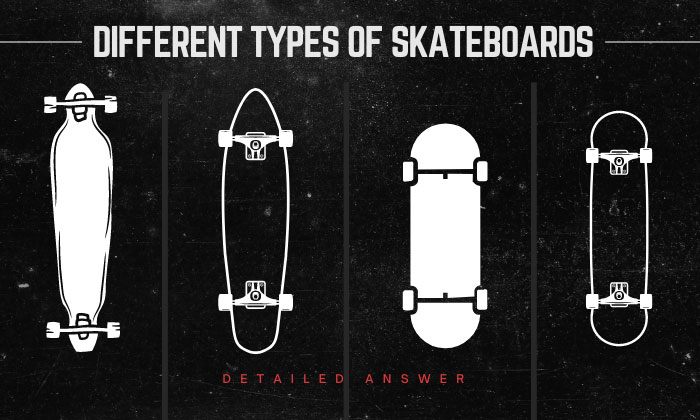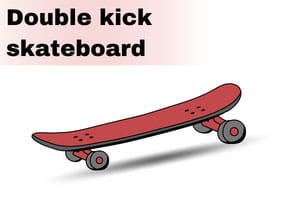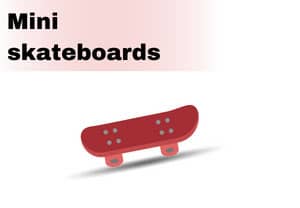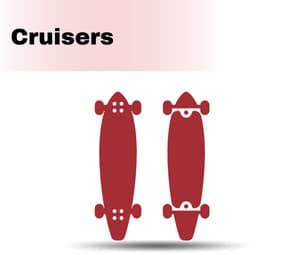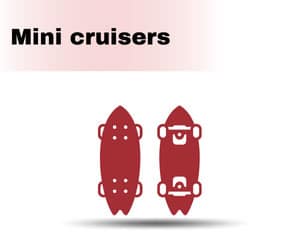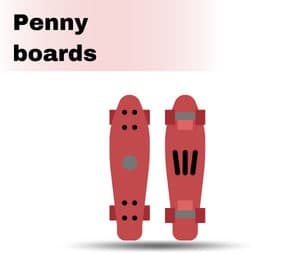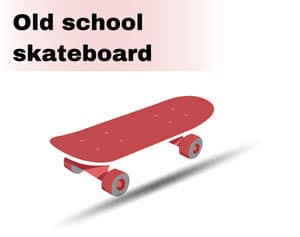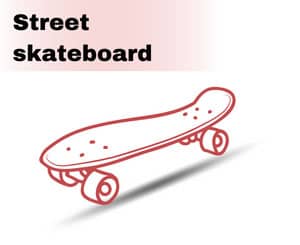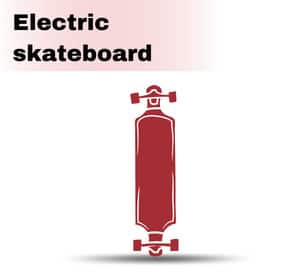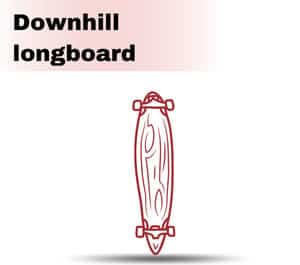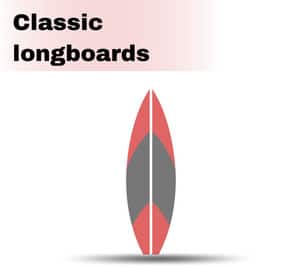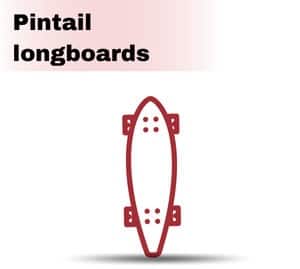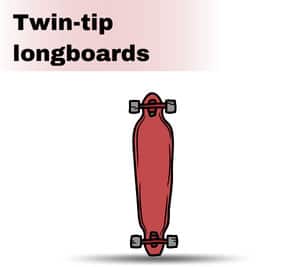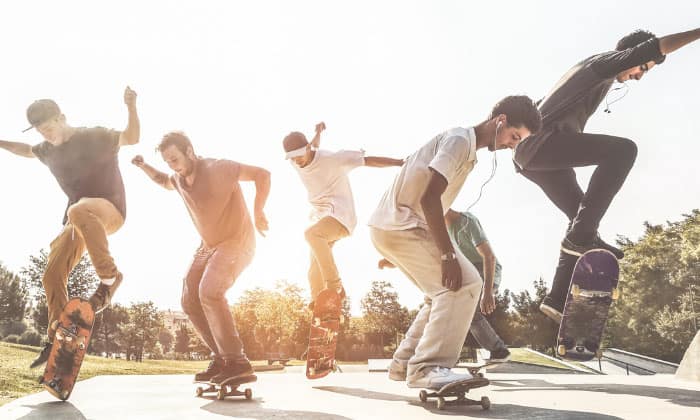As we always say, skateboarding knows no age. No matter how early or late you start, what’s vital is you learn in every step of your journey.
Suppose you’re in your teenage years and want to see if you have a talent for the sport. What’s the best way to find out? The answer is by trying a skateboard.
However, there are many different types of skateboards in the market today. Is that overwhelming? Not if you read this article and allow us to educate you about all types of skateboards, their purposes and their uses, and which will best work for you.
Skateboards: Types, characteristics, purpose, and more
It’s easy to step on a deck, push, and perform tricks. But are we doing these things on the appropriate board?
Let’s learn from this list of skateboards, beginning from the shortboard skateboard types.
Shortboard Skateboard
1. Double kick skateboard
Of all skateboard types, double-kicks are the most popular today. These are the boards characterized by a popsicle silhouette with angled ends.
Double-kick skateboards have thick bodies. And that does not come without a purpose. This type works for technical skating, which includes tricks and stunts on skatepark obstacles. Hence, their decks are thick, and rollers are on the harder side.
While double-kick skateboards are versatile and the most maneuverable, I see one drawback. These designs are not ideal for long-distance and high-speed rides.
2. Mini skateboards
Are there skateboards specially made for young skaters? Absolutely!
Checking around online and physical stores, we see that these skateboards have average dimensions of 7″ to 7.37″ by 28″ to 31.48″. These numbers allow kids and younger users to maneuver the board well and execute tricks more easily.
Do mini skateboards benefit adult skaters? Yes! Many adult riders choose this type because it’s portable.
3. Cruisers
Cruisers are your best option if you don’t want to engage too much in skating tricks.
A cruiser skateboard comes with a thick and spacious deck and regular kingpin trucks rather than the reverse type.
What tricks can you perform with cruiser skateboards? Cruisers have a rear tail. And such a feature can help skaters skip over a few road obstacles.
Yes, cruisers can move over long distances. But on the downside, they may not be as sustainable as longboards. These boards could be less comfortable for transportation.
4. Mini cruisers
Like the classic double-kick skateboard, cruiser boards also have smaller versions in mini cruisers.
These skateboards also have their trademark big, soft wheels. However, their decks are narrower. Why? Because this cruiser type works best for beginners or smaller skateboarders. Nevertheless, adults also use them.
5. Penny boards
How do the two mini skateboards we listed differ from a penny board?
Penny skateboards are more of a collective type. They may come in an old-school shape, street, or cruiser. Constructively, penny skateboards have a polyurethane plastic body. And such a feature makes them smooth and lightweight.
However, the plastic body of a penny board also has drawbacks. One of these aspects is that it doesn’t accommodate big riders well.
6. Old school skateboard
Old school boards are the penultimate parents of the new types of skateboards we use today.
Characterized by affordable yet durable materials, old-school boards became popular in the 1980s. They have broad noses, allowing both tricks and downhill skating to be done. With that, we can say old-school skateboards are also versatile.
If there’s one thing I am less confident about regarding old-school boards, it’s their speed. They may not be as speedy as cruisers or other fast skateboards.
7. Street skateboard
With different kinds of skateboards, how can we ignore the ones that welcome us on the streets?
Street skateboards are versatile, enough to also work in skate parks, but that’s often the double kick’s home. These boards are maneuverable and more adaptive to tricks than regular skating.
However, there are a few downsides for this skateboard type.
First, street skateboards could be lacking in durability because they are thin. Second, they have little concave and are not the best choice for skaters who prioritize stability.
8. Electric skateboard
Do battery-powered skateboards exist? Yes!
Electric skateboards have become a thing in this generation because of their exceptional functionality. Besides moving fast, these skateboards also free the rider from strenuous or tiring movements, like pushing.
These benefits are possible because motors perform most of the mechanical work on the board. And supporting these mini engines are rechargeable batteries that can sustain long rides.
While these skateboards are lightweight for uphill routes, such a feature compromises their stability.
Longboard Skateboards
You might notice we haven’t included the longer skateboards on the list. Let’s discuss them here.
1. Downhill longboard
The most popular longboards are the ones used for downhill skating.
Downhill longboards come with a low deck height and an exceptionally long wheelbase. Such features help the longboard to be more stable and suited for terrain riding.
Perhaps, one of the unique aspects of longboards is how their wheels and trucks sit higher than the deck. And we know regular skateboards aren’t built that way. Such a configuration does not come without a purpose.
Longboards, like skateboards for transportation or long rides, have large wheels. And what’s good about longboard designs is they have notches and cutouts to accommodate these parts plus their trucks.
However, try not to fall backward with this board when riding downhill. And if you can avoid it, don’t bring this board on ramps.
2. Classic longboards
Classics are a more relaxed type of longboard. These items are extensive in width and never get shorter than 33″. And such a size makes them suitable for skaters mastering balance.
If the previous type fits downhill skating, these classic longboards work best on simple commutes.
But if there’s one thing I like the most about this long skateboard, it’s how it makes carving smooth, easy, and quick. Such a thing is possible because of its size, making it more maneuverable.
While it’s inappropriate for doing tricks, I don’t think that is a huge drawback.
3. Pintail longboards
Like the downhill longboard, pintail boards also free some space for taller wheels through their pointed oval deck cut. However, out of many types of skateboard decks, they don’t have drop-through designs. That means the trucks mount from the bottom of the board.
This type of longboard combines speed and sharp carving. And for someone who takes to the city streets daily, I think this feature is an absolute plus.
But unlike other skateboards that let you push from either end, pintail longboards only allow you to drive it from one side. These are not bi-directional boards.
4. Twin-tip longboards
Many skaters confuse this longboard type with a downhill. And we can’t blame them. Twin-tip designs may be symmetrical like downhill ones; however, they can have ends with different shapes as well.
You can use twin-tip decks for downhill races, commuting, and long-distance trips.
Like downhill longboards, the twin tips also have notches and cuts through the deck. These cuts on the side allow for more space for taller wheels. In effect? The board never gets wheel bites, and the skater feels more stable.
Frequently Asked Questions
What are the components of a skateboard?
The number of longboard and skateboard styles could be overwhelming. Nonetheless, their parts are less varied. Here are skateboard components common to all these types.
- Deck – The deck is your ultimate riding platform. Often, it comes as layers of maple wood or other durable materials. Skateboard decks have various sizes, cuts, and shapes to suit diverse riding styles. You will also notice a black sheet layer on top of the deck. That’s the grip tape, a coating designed to help stabilize skaters.
- Trucks – These alloy parts perform much mechanical work on a regular skateboard. They allow the skateboard to turn, pop, or carve around. Subsequently, these parts have vital components in the kingpins, baseplate, hanger, axles, and bushings.
- Wheels – The wheels are the skateboard’s reactors for every push, carve, slide, and many more movements. They come in various hardness levels and sizes to suit particular riding styles. Like the trucks, these rollers also have integral parts in bearings.
How many types of skateboards are there?
All in all, we have listed 12 skateboard kinds.
Eight of these skateboard types names are shortboards, with one powered electronically. And four of these 12 boards fall under the longboard category. As they vary in design and usage, the best way to identify a skateboard’s type is by learning its characteristics.
Conclusion
Your dream to become a skateboarder shouldn’t remain a dream alone. While the learning and mastery process requires time and effort, everything will be worth it once we pull off a new trick or win a competition.
Knowing about the different types of skateboards is one of the best ways to acquaint ourselves with the sport. From there, we’ll learn how to engage with the parts, maintain them, and pick the best pieces for our intended rides.
So, keep in mind the features of different board types and choose the ones that suit your style.

Hi, I am Charles Harris. I opened this site to write as much as I can about my biggest passion – skateboarding!
I started as a clumsy yet passionate rookie 10 years ago to now a still passionate yet much better skateboarder! But I have to tell you, the whole journey has always been fun and rewarding, indeed not without hardship.


